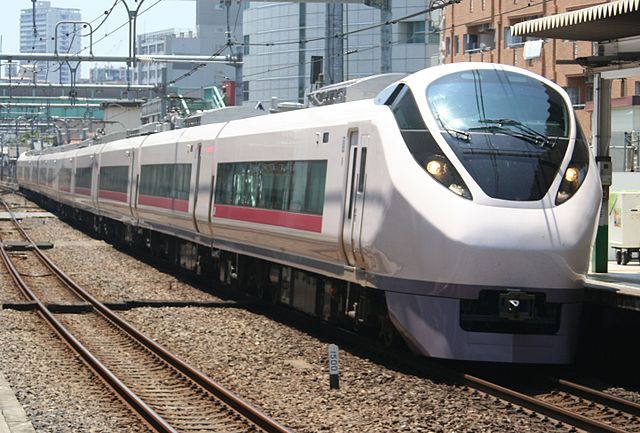 |
| An E657-series train, on a test run at Kita-Senju Station. By Rsa [GFDL or CC-BY-SA-3.0], from Wikimedia Commons |
| Name | Start Station | End Station(s) | Time | Max. Frequency* |
| Hitachi | Shinagawa | Iwaki | 150 minutes | 1 per hour |
| Tokiwa | Shinagawa | Katsuta | 100 minutes | 1 per hour |
| Takahagi | 130 minutes | 4 per day |
The Joban Line starts from centre-city Tokyo and goes northeast until it reaches the Pacific Ocean coast, near Mito and the Hitachi Seaside Park, and follows it northwards until terminating at Sendai. The Hitachi service skips most of the earlier stops ends at Iwaki, the largest city in Fukushima Prefecture, while the Tokiwa makes more stops and terminates earlier on. Traditionally, the Hitachi and Tokiwa both started from Ueno Station. But, on 14 March 2015, the Ueno-Tokyo line was opened, providing through-service between the Tokaido and northern main lines. The Hitachi and Tokiwa take advantage of this by making additional stops at Tokyo and Shinagawa stations, the latter serving as their new terminus.
| Name (English) | Name (Japanese) | Line | Hitachi | Tokiwa |
| Shinagawa | 品川 | JR Tokaido (JT) | O | O |
| Tokyo | 東京 | O | O | |
| Ueno | 上野 | X | X | |
| JR Joban (JJ) | ||||
| Kashiwa | 柏 | I | X | |
| Sanuki | 佐貫 | I | O | |
| Ushiku | 牛久 | I | O | |
| Tsuchiura | 土浦 | I | X | |
| Ishioka | 石岡 | I | X | |
| Tomobe | 友部 | I | X | |
| Akatsuka | 赤塚 | I | O | |
| Kairakuen* | 偕楽園 | O | O | |
| Mito | 水戸 | X | X | |
| Katsuta | 勝田 | X | X | |
| Tokai | 東海 | I | O | |
| Omika | 大甕 | O | O | |
| Hitachi-Taga | 常陸多賀 | O | O | |
| Hitachi | 日立 | X | O | |
| Takahagi | 高萩 | O | O | |
| Isohara | 磯原 | O | O | |
| Nakoso | 勿来 | O | I | |
| Izumi | 泉 | X | I | |
| Yumoto | 湯本 | X | I | |
| Iwaki | いわき | X | I |
X: All trains stop at this station.
O: Some trains stop at this station.
I: No trains stop at this station.
*Kairakuen is a temporary station open only during the plum-blossom season in February/March.
Notable Stops
- Mito: The capital city of Ibaraki Prefecture, and site of Kairaku-en, one of Japan's three most famous landscape gardens, which is famous for plum-tree blossoms in February and March.
- Katsuta: The closest station to Hitachi Seaside Park.
- Hitachi: A seaside city with a sizable cherry blossom festival.
- Izumi: The closest station to the Aquamarine Fukushima aquarium.
- Yumoto: The closest station to the Spa Resort Hawaiians water park.
- Iwaki: The largest city in Fukushima Prefecture.
 |
| An E653-series Super Hitachi train (retired in 2013), passing the plum trees of Kairaku-en. Fumihiko Ueno [CC BY 3.0], via Wikimedia Commons |
| Service | Total Cars | Non-Reserved Cars | Reserved Cars | Green Cars |
| Hitachi | 10 | 0 | 9 (Cars #1-4, 6-10) | 1 (Car #5) |
| Tokiwa | 10 | 0 | 9 (Cars #1-4, 6-10) | 1 (Car #5) |
Tips
- All seats on the Hitachi and Tokiwa require reservations. These are free to make with the Japan Rail Pass and JR East Tohoku Area Pass.
- The JR East Nagano-Niigata Area Pass and Tokyo Wide Pass also cover the Hitachi and Tokiwa, but only up to Isohara, the last stop in Ibaraki prefecture. Users of these passes must pay for any fares beyond that out-of-pocket, up to ¥1,440 (to Iwaki).
- During Kairaku-en's plum blossom festival in February/March, a temporary train station is set up at the park's entrance, between Akatsuka and Mito Stations. At the moment, I have been unable to confirm if Hitachi and/or Tokiwa trains make an additional stop there, or if you will need to transfer to a local at the next closest stop.
- The name "Hitachi" (ひたち) is also the name of Hitachi Province, the former counterpart to present-day Ibaraki Prefecture. As a train service, the name was first used in 1963 for express trains between Ueno and Iwaki*.
- *Iwaki Station was known as Taira Station until 1994.
- The name "Tokiwa" (ときわ) is an alternate reading of Joban (常磐, Jōban), a region encompassing the old Hitachi (常陸国, Hitachi no Kuni) and Iwaki (磐城国, Iwaki no Kuni) provinces, the latter forming the eastern portion of modern-day Fukushima Prefecture. As a train service, the name was first used for another express service between Ueno and Iwaki. It operated from 1958 to 1985.
- The Hitachi was once supplemented by two new services: the Super Hitachi in 1989, and the Fresh Hitachi in 1997. In March 2015, they were renamed simply Hitachi and Tokiwa, respectively.
